Stress Management: Strategies for Organizational Wellbeing and Success
VerifiedAdded on 2023/01/11
|7
|1798
|79
Report
AI Summary
This report delves into the critical issue of stress management within organizations, highlighting its impact on employee performance and overall wellbeing. It explores the causes of workplace stress, such as excessive pressure and job insecurity, and their adverse effects on health, including stress-related illnesses and decreased motivation. The report emphasizes the importance of understanding the difference between stress and pressure, and it outlines various strategies for managing stress, including developing employability skills, setting career goals, and cultivating a positive mindset. Furthermore, it examines the role of leaders in fostering a healthy work environment by focusing on employee engagement, energy management, and creating a supportive culture. The report concludes by emphasizing the benefits of proactive stress management for both individuals and organizations, leading to improved productivity, reduced absenteeism, and enhanced overall success. The document also references several research papers and books to support the arguments.
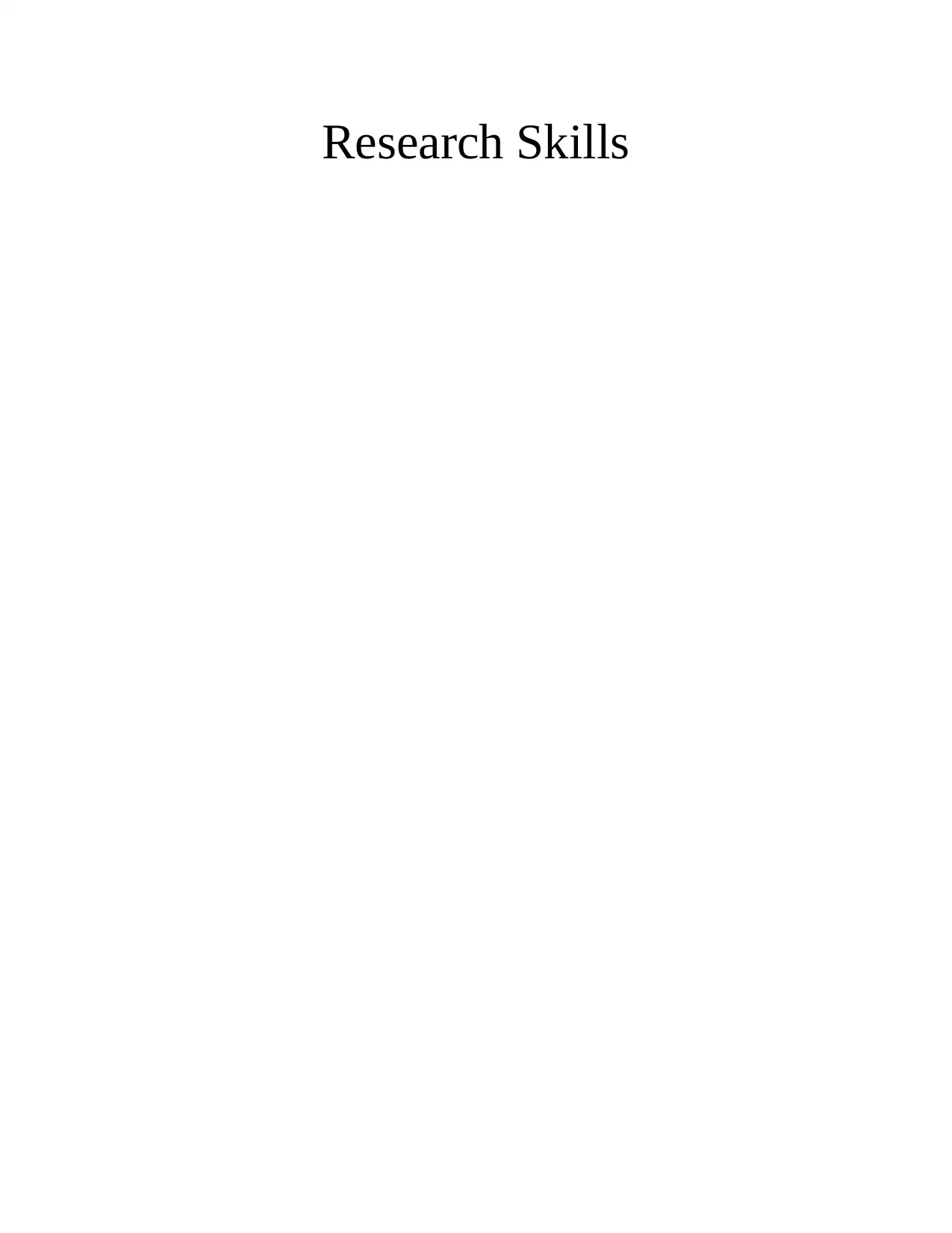
Research Skills
Paraphrase This Document
Need a fresh take? Get an instant paraphrase of this document with our AI Paraphraser

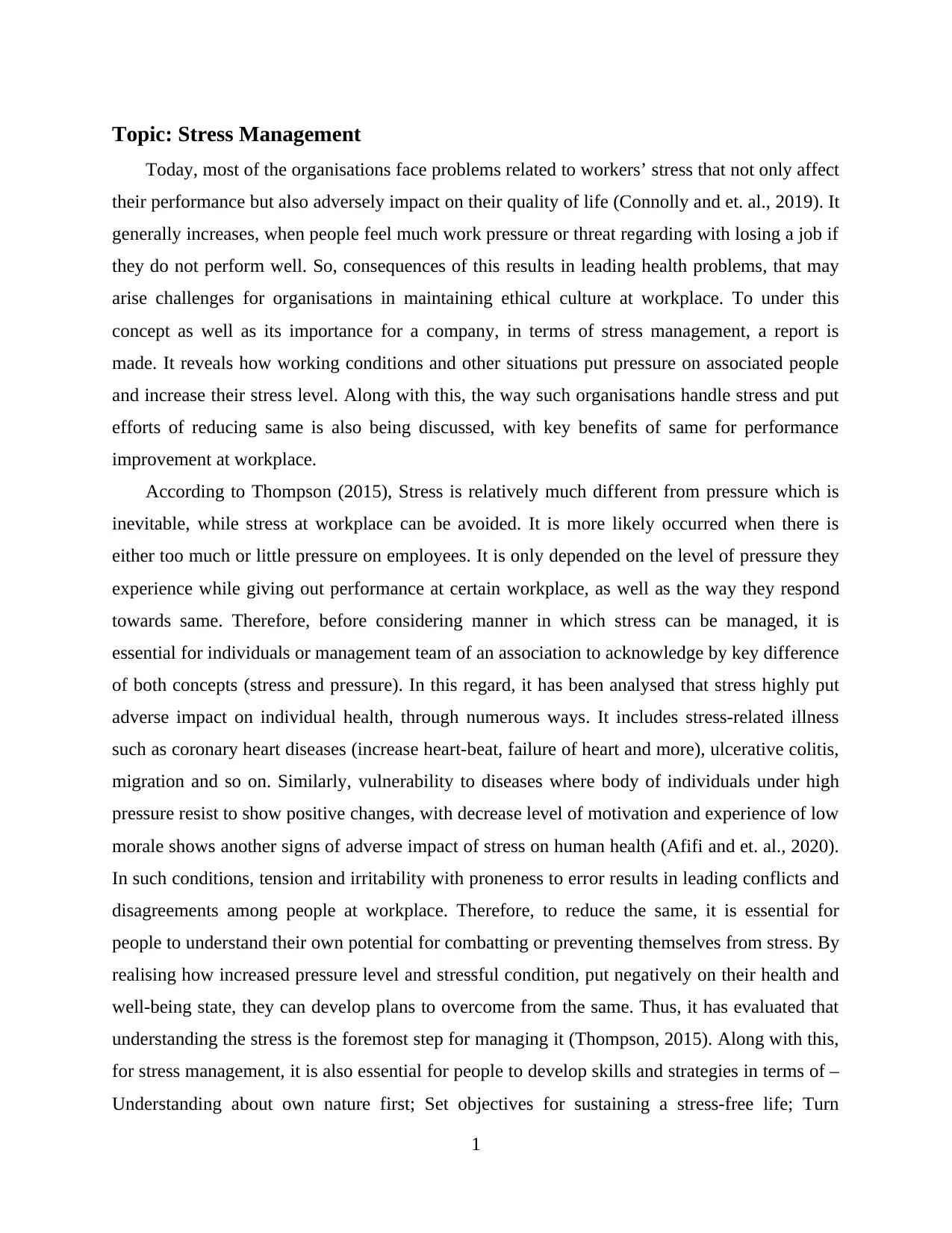
Topic: Stress Management
Today, most of the organisations face problems related to workers’ stress that not only affect
their performance but also adversely impact on their quality of life (Connolly and et. al., 2019). It
generally increases, when people feel much work pressure or threat regarding with losing a job if
they do not perform well. So, consequences of this results in leading health problems, that may
arise challenges for organisations in maintaining ethical culture at workplace. To under this
concept as well as its importance for a company, in terms of stress management, a report is
made. It reveals how working conditions and other situations put pressure on associated people
and increase their stress level. Along with this, the way such organisations handle stress and put
efforts of reducing same is also being discussed, with key benefits of same for performance
improvement at workplace.
According to Thompson (2015), Stress is relatively much different from pressure which is
inevitable, while stress at workplace can be avoided. It is more likely occurred when there is
either too much or little pressure on employees. It is only depended on the level of pressure they
experience while giving out performance at certain workplace, as well as the way they respond
towards same. Therefore, before considering manner in which stress can be managed, it is
essential for individuals or management team of an association to acknowledge by key difference
of both concepts (stress and pressure). In this regard, it has been analysed that stress highly put
adverse impact on individual health, through numerous ways. It includes stress-related illness
such as coronary heart diseases (increase heart-beat, failure of heart and more), ulcerative colitis,
migration and so on. Similarly, vulnerability to diseases where body of individuals under high
pressure resist to show positive changes, with decrease level of motivation and experience of low
morale shows another signs of adverse impact of stress on human health (Afifi and et. al., 2020).
In such conditions, tension and irritability with proneness to error results in leading conflicts and
disagreements among people at workplace. Therefore, to reduce the same, it is essential for
people to understand their own potential for combatting or preventing themselves from stress. By
realising how increased pressure level and stressful condition, put negatively on their health and
well-being state, they can develop plans to overcome from the same. Thus, it has evaluated that
understanding the stress is the foremost step for managing it (Thompson, 2015). Along with this,
for stress management, it is also essential for people to develop skills and strategies in terms of –
Understanding about own nature first; Set objectives for sustaining a stress-free life; Turn
1
Today, most of the organisations face problems related to workers’ stress that not only affect
their performance but also adversely impact on their quality of life (Connolly and et. al., 2019). It
generally increases, when people feel much work pressure or threat regarding with losing a job if
they do not perform well. So, consequences of this results in leading health problems, that may
arise challenges for organisations in maintaining ethical culture at workplace. To under this
concept as well as its importance for a company, in terms of stress management, a report is
made. It reveals how working conditions and other situations put pressure on associated people
and increase their stress level. Along with this, the way such organisations handle stress and put
efforts of reducing same is also being discussed, with key benefits of same for performance
improvement at workplace.
According to Thompson (2015), Stress is relatively much different from pressure which is
inevitable, while stress at workplace can be avoided. It is more likely occurred when there is
either too much or little pressure on employees. It is only depended on the level of pressure they
experience while giving out performance at certain workplace, as well as the way they respond
towards same. Therefore, before considering manner in which stress can be managed, it is
essential for individuals or management team of an association to acknowledge by key difference
of both concepts (stress and pressure). In this regard, it has been analysed that stress highly put
adverse impact on individual health, through numerous ways. It includes stress-related illness
such as coronary heart diseases (increase heart-beat, failure of heart and more), ulcerative colitis,
migration and so on. Similarly, vulnerability to diseases where body of individuals under high
pressure resist to show positive changes, with decrease level of motivation and experience of low
morale shows another signs of adverse impact of stress on human health (Afifi and et. al., 2020).
In such conditions, tension and irritability with proneness to error results in leading conflicts and
disagreements among people at workplace. Therefore, to reduce the same, it is essential for
people to understand their own potential for combatting or preventing themselves from stress. By
realising how increased pressure level and stressful condition, put negatively on their health and
well-being state, they can develop plans to overcome from the same. Thus, it has evaluated that
understanding the stress is the foremost step for managing it (Thompson, 2015). Along with this,
for stress management, it is also essential for people to develop skills and strategies in terms of –
Understanding about own nature first; Set objectives for sustaining a stress-free life; Turn
1
⊘ This is a preview!⊘
Do you want full access?
Subscribe today to unlock all pages.

Trusted by 1+ million students worldwide
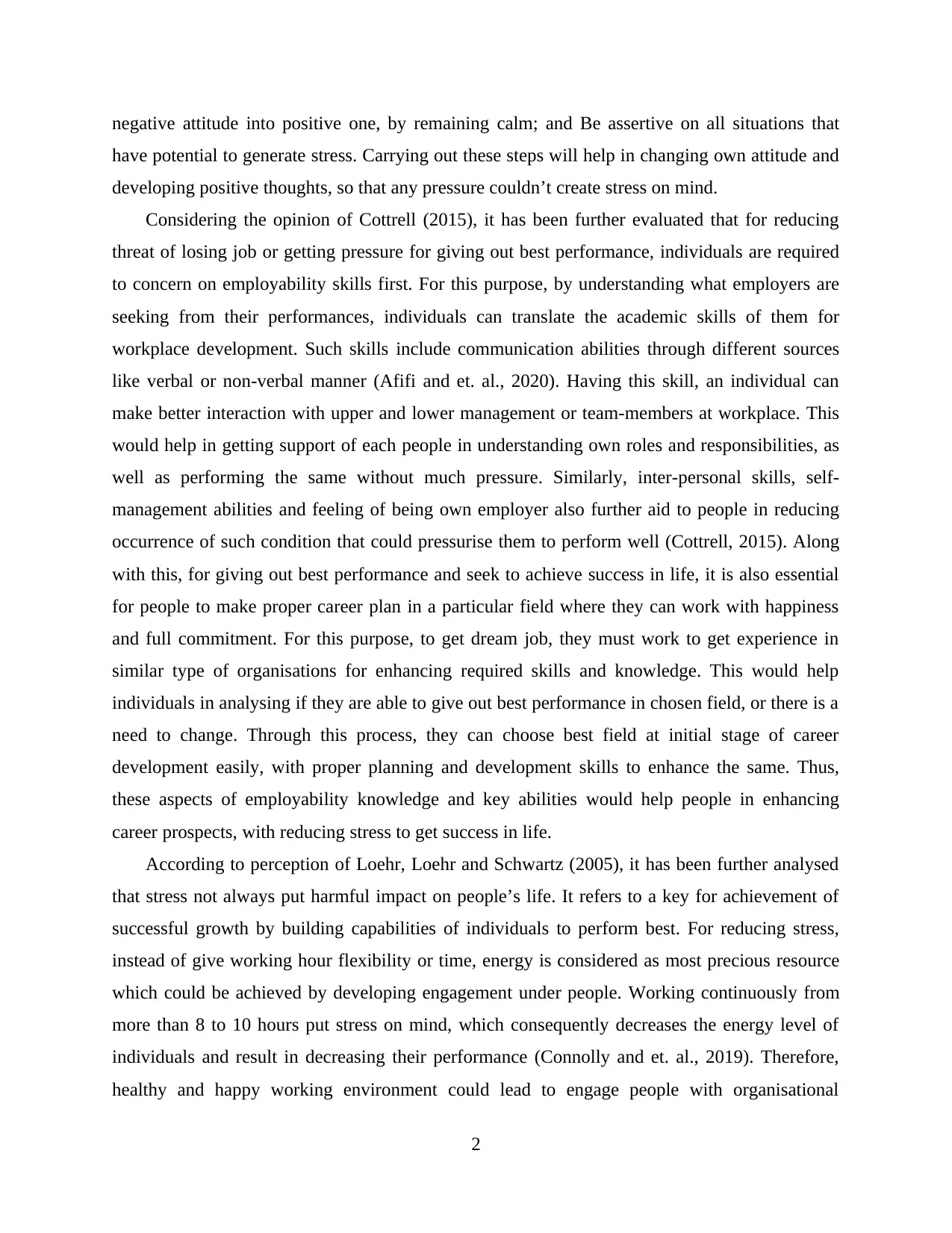
negative attitude into positive one, by remaining calm; and Be assertive on all situations that
have potential to generate stress. Carrying out these steps will help in changing own attitude and
developing positive thoughts, so that any pressure couldn’t create stress on mind.
Considering the opinion of Cottrell (2015), it has been further evaluated that for reducing
threat of losing job or getting pressure for giving out best performance, individuals are required
to concern on employability skills first. For this purpose, by understanding what employers are
seeking from their performances, individuals can translate the academic skills of them for
workplace development. Such skills include communication abilities through different sources
like verbal or non-verbal manner (Afifi and et. al., 2020). Having this skill, an individual can
make better interaction with upper and lower management or team-members at workplace. This
would help in getting support of each people in understanding own roles and responsibilities, as
well as performing the same without much pressure. Similarly, inter-personal skills, self-
management abilities and feeling of being own employer also further aid to people in reducing
occurrence of such condition that could pressurise them to perform well (Cottrell, 2015). Along
with this, for giving out best performance and seek to achieve success in life, it is also essential
for people to make proper career plan in a particular field where they can work with happiness
and full commitment. For this purpose, to get dream job, they must work to get experience in
similar type of organisations for enhancing required skills and knowledge. This would help
individuals in analysing if they are able to give out best performance in chosen field, or there is a
need to change. Through this process, they can choose best field at initial stage of career
development easily, with proper planning and development skills to enhance the same. Thus,
these aspects of employability knowledge and key abilities would help people in enhancing
career prospects, with reducing stress to get success in life.
According to perception of Loehr, Loehr and Schwartz (2005), it has been further analysed
that stress not always put harmful impact on people’s life. It refers to a key for achievement of
successful growth by building capabilities of individuals to perform best. For reducing stress,
instead of give working hour flexibility or time, energy is considered as most precious resource
which could be achieved by developing engagement under people. Working continuously from
more than 8 to 10 hours put stress on mind, which consequently decreases the energy level of
individuals and result in decreasing their performance (Connolly and et. al., 2019). Therefore,
healthy and happy working environment could lead to engage people with organisational
2
have potential to generate stress. Carrying out these steps will help in changing own attitude and
developing positive thoughts, so that any pressure couldn’t create stress on mind.
Considering the opinion of Cottrell (2015), it has been further evaluated that for reducing
threat of losing job or getting pressure for giving out best performance, individuals are required
to concern on employability skills first. For this purpose, by understanding what employers are
seeking from their performances, individuals can translate the academic skills of them for
workplace development. Such skills include communication abilities through different sources
like verbal or non-verbal manner (Afifi and et. al., 2020). Having this skill, an individual can
make better interaction with upper and lower management or team-members at workplace. This
would help in getting support of each people in understanding own roles and responsibilities, as
well as performing the same without much pressure. Similarly, inter-personal skills, self-
management abilities and feeling of being own employer also further aid to people in reducing
occurrence of such condition that could pressurise them to perform well (Cottrell, 2015). Along
with this, for giving out best performance and seek to achieve success in life, it is also essential
for people to make proper career plan in a particular field where they can work with happiness
and full commitment. For this purpose, to get dream job, they must work to get experience in
similar type of organisations for enhancing required skills and knowledge. This would help
individuals in analysing if they are able to give out best performance in chosen field, or there is a
need to change. Through this process, they can choose best field at initial stage of career
development easily, with proper planning and development skills to enhance the same. Thus,
these aspects of employability knowledge and key abilities would help people in enhancing
career prospects, with reducing stress to get success in life.
According to perception of Loehr, Loehr and Schwartz (2005), it has been further analysed
that stress not always put harmful impact on people’s life. It refers to a key for achievement of
successful growth by building capabilities of individuals to perform best. For reducing stress,
instead of give working hour flexibility or time, energy is considered as most precious resource
which could be achieved by developing engagement under people. Working continuously from
more than 8 to 10 hours put stress on mind, which consequently decreases the energy level of
individuals and result in decreasing their performance (Connolly and et. al., 2019). Therefore,
healthy and happy working environment could lead to engage people with organisational
2
Paraphrase This Document
Need a fresh take? Get an instant paraphrase of this document with our AI Paraphraser
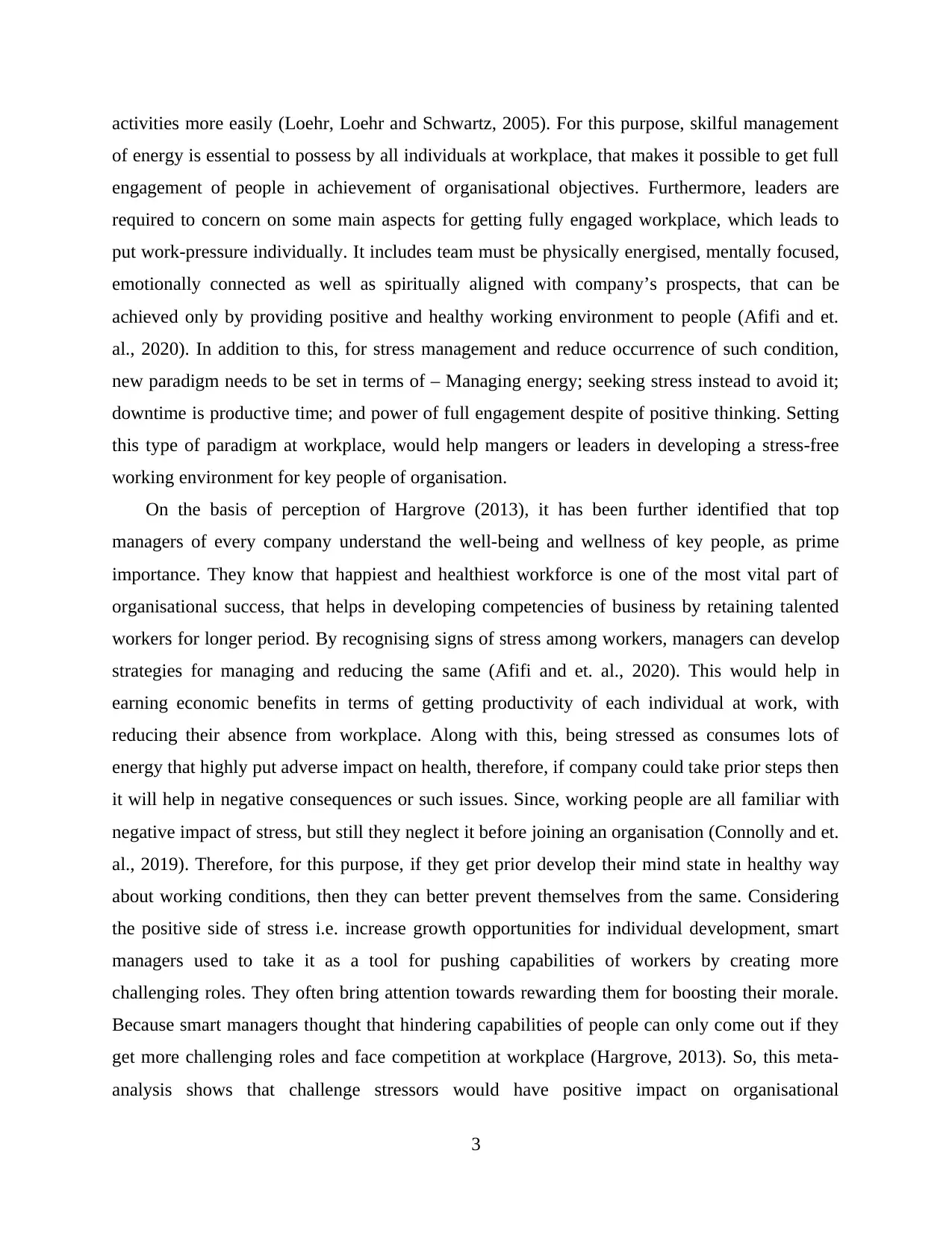
activities more easily (Loehr, Loehr and Schwartz, 2005). For this purpose, skilful management
of energy is essential to possess by all individuals at workplace, that makes it possible to get full
engagement of people in achievement of organisational objectives. Furthermore, leaders are
required to concern on some main aspects for getting fully engaged workplace, which leads to
put work-pressure individually. It includes team must be physically energised, mentally focused,
emotionally connected as well as spiritually aligned with company’s prospects, that can be
achieved only by providing positive and healthy working environment to people (Afifi and et.
al., 2020). In addition to this, for stress management and reduce occurrence of such condition,
new paradigm needs to be set in terms of – Managing energy; seeking stress instead to avoid it;
downtime is productive time; and power of full engagement despite of positive thinking. Setting
this type of paradigm at workplace, would help mangers or leaders in developing a stress-free
working environment for key people of organisation.
On the basis of perception of Hargrove (2013), it has been further identified that top
managers of every company understand the well-being and wellness of key people, as prime
importance. They know that happiest and healthiest workforce is one of the most vital part of
organisational success, that helps in developing competencies of business by retaining talented
workers for longer period. By recognising signs of stress among workers, managers can develop
strategies for managing and reducing the same (Afifi and et. al., 2020). This would help in
earning economic benefits in terms of getting productivity of each individual at work, with
reducing their absence from workplace. Along with this, being stressed as consumes lots of
energy that highly put adverse impact on health, therefore, if company could take prior steps then
it will help in negative consequences or such issues. Since, working people are all familiar with
negative impact of stress, but still they neglect it before joining an organisation (Connolly and et.
al., 2019). Therefore, for this purpose, if they get prior develop their mind state in healthy way
about working conditions, then they can better prevent themselves from the same. Considering
the positive side of stress i.e. increase growth opportunities for individual development, smart
managers used to take it as a tool for pushing capabilities of workers by creating more
challenging roles. They often bring attention towards rewarding them for boosting their morale.
Because smart managers thought that hindering capabilities of people can only come out if they
get more challenging roles and face competition at workplace (Hargrove, 2013). So, this meta-
analysis shows that challenge stressors would have positive impact on organisational
3
of energy is essential to possess by all individuals at workplace, that makes it possible to get full
engagement of people in achievement of organisational objectives. Furthermore, leaders are
required to concern on some main aspects for getting fully engaged workplace, which leads to
put work-pressure individually. It includes team must be physically energised, mentally focused,
emotionally connected as well as spiritually aligned with company’s prospects, that can be
achieved only by providing positive and healthy working environment to people (Afifi and et.
al., 2020). In addition to this, for stress management and reduce occurrence of such condition,
new paradigm needs to be set in terms of – Managing energy; seeking stress instead to avoid it;
downtime is productive time; and power of full engagement despite of positive thinking. Setting
this type of paradigm at workplace, would help mangers or leaders in developing a stress-free
working environment for key people of organisation.
On the basis of perception of Hargrove (2013), it has been further identified that top
managers of every company understand the well-being and wellness of key people, as prime
importance. They know that happiest and healthiest workforce is one of the most vital part of
organisational success, that helps in developing competencies of business by retaining talented
workers for longer period. By recognising signs of stress among workers, managers can develop
strategies for managing and reducing the same (Afifi and et. al., 2020). This would help in
earning economic benefits in terms of getting productivity of each individual at work, with
reducing their absence from workplace. Along with this, being stressed as consumes lots of
energy that highly put adverse impact on health, therefore, if company could take prior steps then
it will help in negative consequences or such issues. Since, working people are all familiar with
negative impact of stress, but still they neglect it before joining an organisation (Connolly and et.
al., 2019). Therefore, for this purpose, if they get prior develop their mind state in healthy way
about working conditions, then they can better prevent themselves from the same. Considering
the positive side of stress i.e. increase growth opportunities for individual development, smart
managers used to take it as a tool for pushing capabilities of workers by creating more
challenging roles. They often bring attention towards rewarding them for boosting their morale.
Because smart managers thought that hindering capabilities of people can only come out if they
get more challenging roles and face competition at workplace (Hargrove, 2013). So, this meta-
analysis shows that challenge stressors would have positive impact on organisational
3
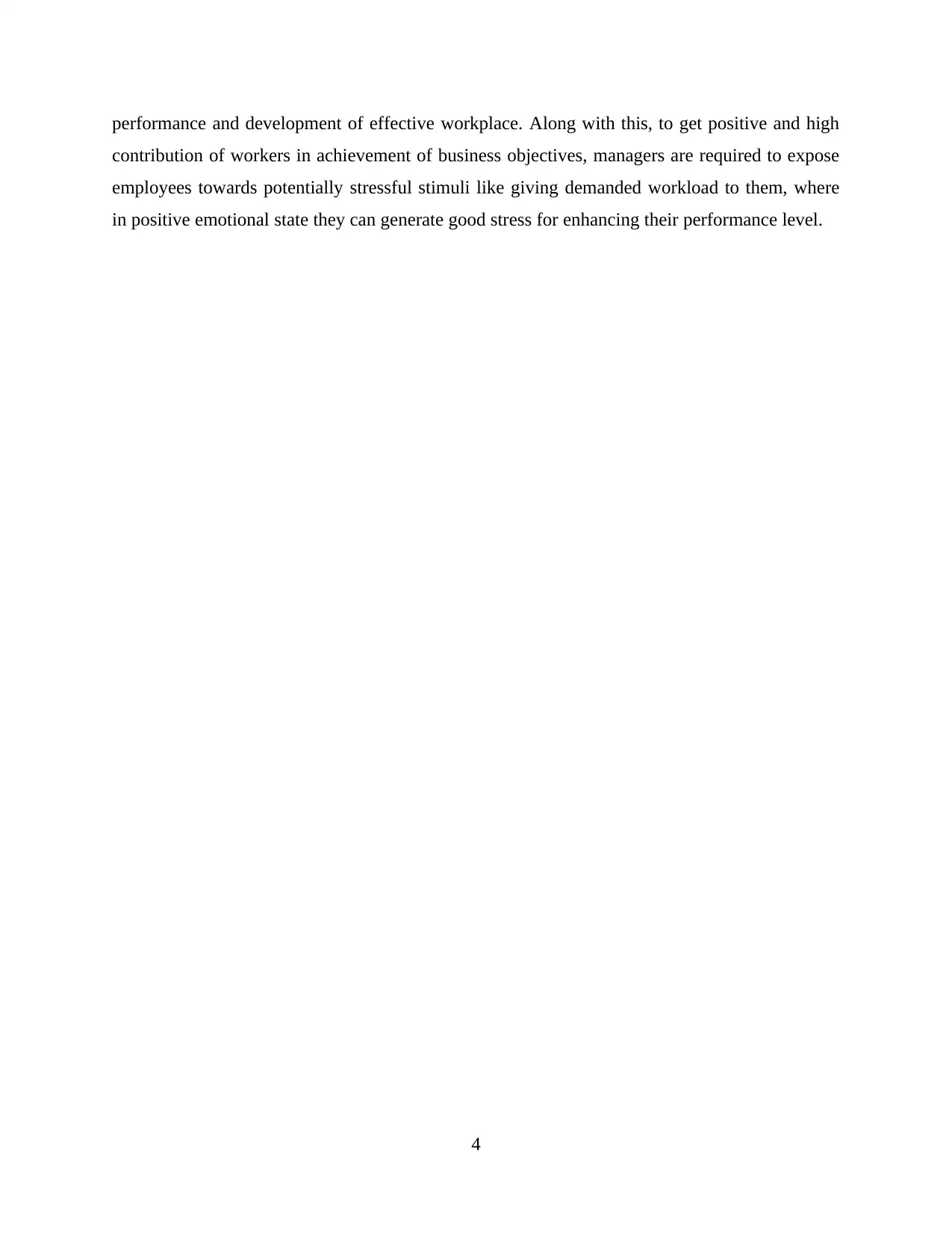
performance and development of effective workplace. Along with this, to get positive and high
contribution of workers in achievement of business objectives, managers are required to expose
employees towards potentially stressful stimuli like giving demanded workload to them, where
in positive emotional state they can generate good stress for enhancing their performance level.
4
contribution of workers in achievement of business objectives, managers are required to expose
employees towards potentially stressful stimuli like giving demanded workload to them, where
in positive emotional state they can generate good stress for enhancing their performance level.
4
⊘ This is a preview!⊘
Do you want full access?
Subscribe today to unlock all pages.

Trusted by 1+ million students worldwide
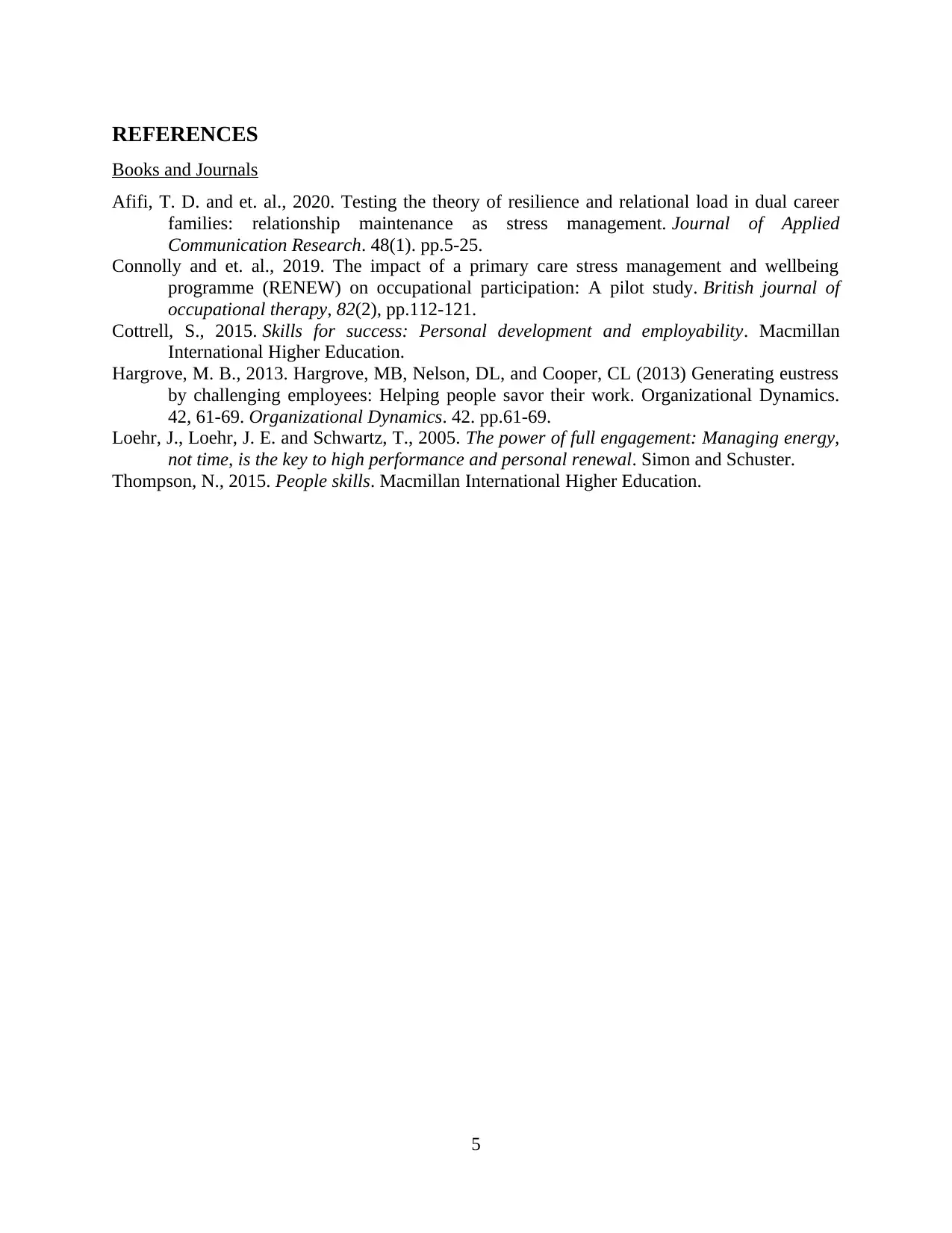
REFERENCES
Books and Journals
Afifi, T. D. and et. al., 2020. Testing the theory of resilience and relational load in dual career
families: relationship maintenance as stress management. Journal of Applied
Communication Research. 48(1). pp.5-25.
Connolly and et. al., 2019. The impact of a primary care stress management and wellbeing
programme (RENEW) on occupational participation: A pilot study. British journal of
occupational therapy, 82(2), pp.112-121.
Cottrell, S., 2015. Skills for success: Personal development and employability. Macmillan
International Higher Education.
Hargrove, M. B., 2013. Hargrove, MB, Nelson, DL, and Cooper, CL (2013) Generating eustress
by challenging employees: Helping people savor their work. Organizational Dynamics.
42, 61-69. Organizational Dynamics. 42. pp.61-69.
Loehr, J., Loehr, J. E. and Schwartz, T., 2005. The power of full engagement: Managing energy,
not time, is the key to high performance and personal renewal. Simon and Schuster.
Thompson, N., 2015. People skills. Macmillan International Higher Education.
5
Books and Journals
Afifi, T. D. and et. al., 2020. Testing the theory of resilience and relational load in dual career
families: relationship maintenance as stress management. Journal of Applied
Communication Research. 48(1). pp.5-25.
Connolly and et. al., 2019. The impact of a primary care stress management and wellbeing
programme (RENEW) on occupational participation: A pilot study. British journal of
occupational therapy, 82(2), pp.112-121.
Cottrell, S., 2015. Skills for success: Personal development and employability. Macmillan
International Higher Education.
Hargrove, M. B., 2013. Hargrove, MB, Nelson, DL, and Cooper, CL (2013) Generating eustress
by challenging employees: Helping people savor their work. Organizational Dynamics.
42, 61-69. Organizational Dynamics. 42. pp.61-69.
Loehr, J., Loehr, J. E. and Schwartz, T., 2005. The power of full engagement: Managing energy,
not time, is the key to high performance and personal renewal. Simon and Schuster.
Thompson, N., 2015. People skills. Macmillan International Higher Education.
5
1 out of 7
Related Documents
Your All-in-One AI-Powered Toolkit for Academic Success.
+13062052269
info@desklib.com
Available 24*7 on WhatsApp / Email
![[object Object]](/_next/static/media/star-bottom.7253800d.svg)
Unlock your academic potential
Copyright © 2020–2025 A2Z Services. All Rights Reserved. Developed and managed by ZUCOL.





